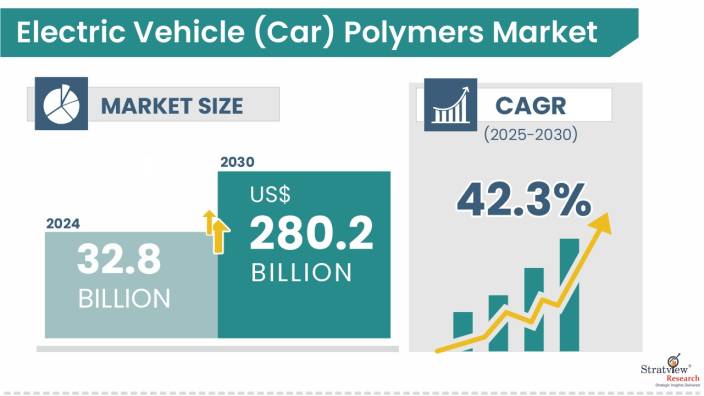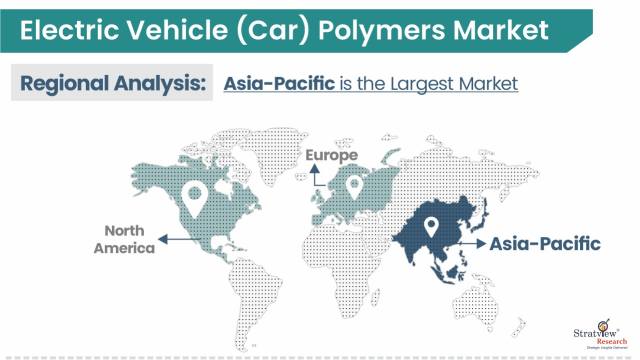Market Insights
The electric vehicle (car) polymers market was estimated at USD 32.8 billion in 2024 and is likely to grow at a CAGR of 42.3% during 2025-2030 to reach USD 280.2 billion in 2030.

Wish to get a free sample? Click Here
Market Dynamics
Introduction
Polymers are used in electric cars to reduce the weight without affecting the efficiency of the car. Polymers replacing metals have similar properties to metals, such as flame retardancy, abrasion resistance, stiffness, toughness, electrical insulation, and heat resistance.
Market Drivers
The key factors driving the market for electric vehicle (car) polymers are:
- The growing demand for electric vehicles among the emerging economies of the Asia-Pacific region, such as China and India
- The rapid increase in government regulations in order to reduce CO2 emissions
- The development of charging infrastructure in the developing as well as developed nations
Segments Analysis
|
Segmentations
|
List of Sub-Segments
|
Segments with High Growth Opportunity
|
|
Type Analysis
|
Engineering Plastics, Elastomers
|
The elastomers segment is expected to fuel the major share of the market during the forecast period.
|
|
Component Type Analysis
|
Powertrain System, Exterior, and Interior
|
The interior segment of components is witnessing a significant transformation by the replacement of metals with polymers.
|
|
Regional Analysis
|
North America, Europe, Asia-Pacific, and Rest of the World
|
Asia-Pacific is estimated to dominate the overall market for electric vehicle (car) polymers during the forecast period.
|
By Type
Based on the type, the market is segmented as engineering plastics and elastomers. The elastomers segment is expected to fuel the major share of the market during the forecast period as elastomers find their extensive usage in insulation in cars and also in the manufacturing of tires.
By Component Type
Based on the component type, the electric vehicle (car) polymers market is segmented as powertrain system, exterior, and interior. The interior segment of components is witnessing a significant transformation by the replacement of metals with polymers, as components made with polymers have lower accidental risk and safety issues. Therefore, electric car manufacturers are employing polymers, instead of metals, in the interiors of electric cars, which also reduces the overall weight of electric cars. Polymer has proven to be the ideal material for the interior components of a car, as it is durable and aesthetically pleasing, also reducing the noise, vibration, and harshness (NVH) levels of an electric car. All these factors are likely to drive the growth of the segment during the forecast period.
Regional Insights
In terms of regions, Asia-Pacific is estimated to dominate the overall market for electric vehicle (car) polymers during the forecast period. The region has emerged as the largest consumer of electric vehicle (car) polymers, owing to the surge in production of electric cars in China, Japan, South Korea, among other countries. Growing concern for reducing the level of carbon footprints, increasing government support, and reduction in the overall weight of electric cars are the major factors bolstering the growth of the market for electric vehicle (car) polymers in the Asia-Pacific region. North America and Europe are also expected to offer promising growth opportunities during the forecast period.

Know the high-growth countries in this report. Register Here
Key Players
Some of the major electric vehicle (car) polymer manufacturers are:
- BASF SE
- DowDuPont
- Covestro AG
- Celanese Corporation
- SABIC
- Solvay S.A.
- LANXESS AG
- LG Chem Ltd.
- Asahi Kasei Corporation
- Evonik Industries AG
Note: The above list does not necessarily include all the top players in the market.
Are you the leading player in this market? We would love to include your name. Write to us at [email protected]
Research Methodology
This strategic assessment report, from Stratview Research, provides a comprehensive analysis that reflects today’s electric vehicle (car) polymers market realities and future market possibilities for the forecast period of 2025 to 2030. After a continuous interest in our electric vehicle (car) polymers market report from the industry stakeholders, we have tried to further accentuate our research scope to the electric vehicle (car) polymers market to provide the most crystal-clear picture of the market. The report segments and analyzes the market in the most detailed manner to provide a panoramic view of the market. The vital data/information provided in the report can play a crucial role for the market participants as well as investors in the identification of the low-hanging fruits available in the market as well as to formulate the growth strategies to expedite their growth process.
This report offers high-quality insights and is the outcome of a detailed research methodology comprising extensive secondary research, rigorous primary interviews with industry stakeholders, and validation and triangulation with Stratview Research’s internal database and statistical tools. More than 1000 authenticated secondary sources, such as company annual reports, fact books, press releases, journals, investor presentations, white papers, patents, and articles, have been leveraged to gather the data. We conducted more than 15 detailed primary interviews with the market players across the value chain in all four regions and industry experts to obtain both qualitative and quantitative insights.
Report Features
This report provides market intelligence in the most comprehensive way. The report structure has been kept such that it offers maximum business value. It provides critical insights into market dynamics and will enable strategic decision-making for existing market players as well as those willing to enter the market. The following are the key features of the report:
- Market structure: Overview, industry life cycle analysis, and supply chain analysis.
- Market environment analysis: Growth drivers and constraints, Porter’s five forces analysis, and SWOT analysis.
- Market trend and forecast analysis.
- Market segment trend and forecast.
- Competitive landscape and dynamics: Market share, Service portfolio, New Product Launches, etc.
- COVID-19 impact and its recovery curve
- Attractive market segments and associated growth opportunities.
- Emerging trends.
- Strategic growth opportunities for the existing and new players.
- Key success factors
Market Segmentation
This report studies the market, covering a period of 12 years of trends and forecasts. The report provides detailed insights into the market dynamics to enable informed business decision-making and growth strategy formulation based on the opportunities present in the market.
The electric vehicle (car) polymers market is segmented into the following categories:
By Type
- Engineering Plastics
- (Type Analysis: Acrylonitrile Butadiene Styrene (ABS), Polyamide, Polycarbonate, Polyphenylene Sulfide (PPS), Polyurethane, Polypropylene, Fluoropolymer, Thermoplastic Polyester, and Others)
- Elastomers
- (Type Analysis: Synthetic Rubber, Natural Rubber, Fluoroelastomer, Silicone Elastomer, Others)
By Component Type
- Powertrain System
- Exterior
- Interior
By Region
- North America (Country Analysis: the USA, Canada, and Mexico)
- Europe (Country Analysis: Germany, France, the UK, Norway, Sweden, the Netherlands, and Rest of Europe)
- Asia-Pacific (Country Analysis: China, Japan, India, South Korea, and Rest of Asia-Pacific)
- Rest of the World (Sub-Region Analysis: Latin America, the Middle East, and Others)
Report Customization Options
With this detailed report, Stratview Research offers one of the following free customization options to our respectable clients:
Company Profiling
- Detailed profiling of additional market players (up to 3 players)
- SWOT analysis of key players (up to 3 players)
Market Segmentation
- Current market segmentation of any one of the types by component type.
Competitive Benchmarking
- Benchmarking of key players on the following parameters: Product portfolio, geographical reach, regional presence, and strategic alliances.
Custom Research: Stratview Research offers custom research services across sectors. In case of any custom research requirement related to market assessment, competitive benchmarking, sourcing and procurement, target screening, and others, please send your inquiry to [email protected].

